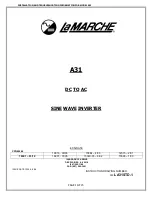
Wiring the Inverter/Charger
975-0209-01-01
2–11
DC disconnects
The DC circuit from the battery to the inverter/charger must be equipped with a
disconnect and over-current protection device. (Refer to your applicable
installation code.)
Type
This device usually consists of a circuit breaker, a “fused-disconnect,” or a
separate fuse and DC disconnect. Do not confuse AC circuit breakers with DC
circuit breakers. They are not interchangeable.
Rating
The rating of the fuse or breaker must be matched to the size of cables used, in
accordance with the applicable installation codes.
Location
The breaker or fuse and disconnect should be located as close as possible to the
battery in the positive cable. The U.S. NEC (NFPA 70) specifies that the
protection can be no further than 18 inches from the battery. If using a fuse and
disconnect, the disconnect must be installed between the battery and the fuse.
Connection of Grounding and Battery Systems
This inverter/charger should be connected to a grounded, permanent wiring
system. For most installations, the negative battery conductor should be bonded to
the grounding system at one (and only one) point in the system. All installations
should comply with all national and local codes and ordinances.
Figure 2-4 outlines proper connections for the RV Series inverter/chargers.
CAUTION
•
DO NOT connect the black battery negative (–) terminal to the vehicle chassis ground.
•
DO NOT connect the DC load negative to the black battery negative (–). Connect only
to the green chassis ground terminal on the inverter or to the vehicle chassis. The
purpose of this terminal is to ensure that all DC load current into or out of the battery
bank will flow through the internal shunt of the inverter. The internal shunt is
connected between the black battery negative terminal and the green chassis ground
terminal of the inverter. Because all DC loads in a vehicle are generally connected to a
common chassis ground and not directly to the battery negative (in a negative-ground
system), all DC current in the system will at some point pass through the chassis and
then into the battery bank. If the inverter is in this loop the net current flow is easily
monitored. Thus, the remote control’s battery fuel gauge feature is possible. You may
connect the system without going through the chassis ground terminal, but the fuel
gauge feature will not work properly.
Содержание RV2012GS
Страница 2: ......
Страница 5: ...RV Series Inverter Charger Owner s Manual ...
Страница 10: ...viii ...
Страница 18: ...1 6 ...
Страница 52: ...3 12 ...
Страница 53: ...4 Troubleshooting Chapter 4 contains information and procedures to troubleshoot the RV Series Inverter Charger ...
Страница 58: ...A 4 ...
Страница 63: ......
















































